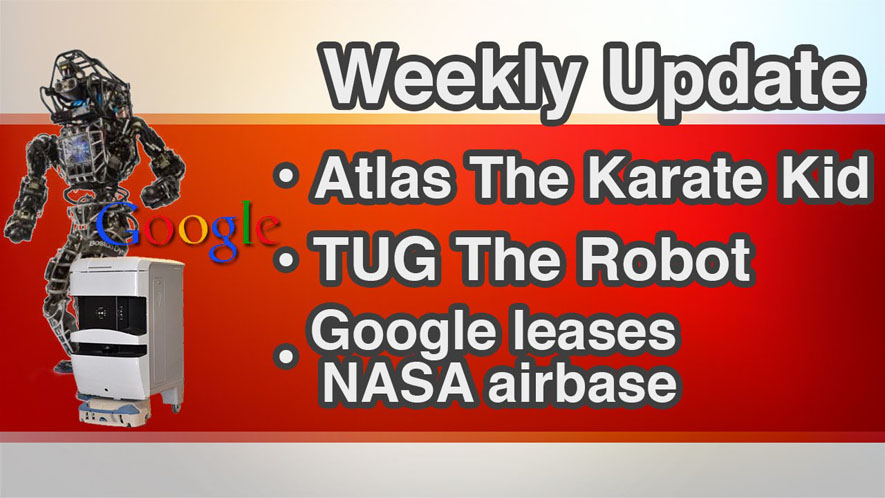Hi there and welcome to my weekly robot update.
This is where I do a roundup of what is going on in the robot news around the world so stay tuned.
Hi guys I’m Philip English from robophil.com and welcome to the robot weekly update number 4.
Atlas the Karate Kid Robot
The Google-owned robotics company Boston Dynamics has created a 6 foot 2 inches, 330-pound robot that can mimic the moves of The Karate Kid.
Atlas, the robot, is not quite a full-blown ninja yet in his new video.
But the robot is shown balancing on a cinderblock on one leg and raising his arms slowly in the air, as in the iconic movie scene where Ralph Macchio unleashes the crane kick. While Boston Dynamics built the hardware, a robotics research institute called IHMC programmed the robot’s moves.
When not practicing karate, the Atlas robots are actually designed to provide humanitarian relief in areas that people cannot enter, such as nuclear disaster sites. Boston Dynamics has also created a robotic dog and a wildcat that can run at speeds of 25 miles an hour.
Atlas is a high mobility, humanoid robot designed to negotiate outdoor, rough terrain. Atlas can walk bipedally leaving the upper limbs free to lift, carry, and manipulate the environment. In extremely challenging terrain, Atlas is strong and coordinated enough to climb using hands and feet to pick its way through congested spaces.
Articulated, sensate hands will enable Atlas to use tools for human use. Atlas includes 28 hydraulically-actuated degrees of freedom, two hands, arms, legs, feet and a torso.
An articulated sensor includes stereo cameras and a laser range finder. Atlas is powered from an off-board, electric motor supply via a flexible tether.
Several copies of the Atlas robot were provided. The Government Furnished Equipment for the DARPA Robotics Challenge program. This was delivered in the summer of 2013.
TUG – the hospital robot.
TUG is a smart autonomous mobile robot that has become a common sight in hospitals and delivers materials and supplies. TUG efficiently delivers medications, lab specimens, food, and linens and removes trash and waste. It has a measurable ROI and provides tangible improvements in care.
TUG can be used by any department that needs to transport materials to the point of use. A wide variety of carts can be rolled onto its stainless steel lift for delivery. Materials that must be secured can be delivered using integrated drawer or door carts enabled with biometric access and pin-code security.
TUG has many different benefits.
Starting with 24×7 improved productivity.
TUG works around the clock.
It is a substitute for the labor needed to haul and transport goods, materials and clinical supplies within the hospital.
Secure.
Integrated drawer and door carts provide biometric security plus pin code access to protect and ensure secure delivery of sensitive medications or laboratory specimens.
Patient Safety.
When clinical staff become distracted to look for missing materials or medications, they make mistakes and patient care suffers. If they are preoccupied with logistics tasks, they are unable to spend that time attending to the needs of the patient.
Enhances the High-Tech Hospital.
The TUG is a highly visible investment as it travels the halls, rides elevators and audibly speaks while performing its tasks. Hospitals using the TUG are serious about improving efficiency. It enhances their reputation as being on the leading edge of medical care.
Google releases a NASA air base for robots, planes and space exploration.
Google has released a NASA air field in San Francisco with three hangars capable of housing robotics research and space-exploration vehicles.
The 60-year, 1.2 billion dollars, 732 million pounds, lease of Moffett Field Naval Air Station on the San Francisco peninsula includes a 200 million dollar commitment to refurbish the hangars and improve the site with a museum and educational facilities.
The 1,000 acre site includes a private golf course, a working airfield, two runways, an operations building and three large hangars, including the historic Hangar One. Google secured the lease through its real estate subsidiary, Planetary Ventures for “research, development, assembly and testing in the areas of space exploration, aviation, rover/robotics and other emerging technologies”.
Google’s founders, Larry Page and Sergey Brin, have expressed interests in both aviation and space exploration before, offering a 20 million dollar prize to any private company that can land a robot on the moon, travel 500m and send back images before the end of 2015.
The company recently acquired several robotics and satellite firms, including Boston Dynamics – the robotics outfit responsible for the military robotic packhorse Big Dog, the running robot Cheetah and the humanoid robot Atlas.
The robotics, satellite and space ventures fall under Google’s “moonshot” X Lab responsible for Google Glass, Project Loon and most recently a venture into health care and medical equipment including a cancer- and heart-attack detecting pill.
That’s it guys for the weekly world robot news. I’m your host, Philip English.
If you liked this robot report and want to see the latest news, reviews, and robot tutorials, then please hit the subscribe button above and come visit us at robophil.com to keep up to date. I placed further information about the robots in the weekly robot update in the links below. As well as web links for your review.
If you have any robot products that you like me to do review on or to do a tutorial on, then please pay me an email over at robophil.com and I will see what I can do.
Thanks guys. I’m looking forward to see you next time.
Atlast The Karate Kid | TUG The Robot | Google releases NASA Airbase: RoboPhil Weekly Update YouTube: https://youtu.be/qxeqJummzgA
Philip English: https://philipenglish.com
Sponsor: Robot Center: http://www.robotcenter.co.uk

